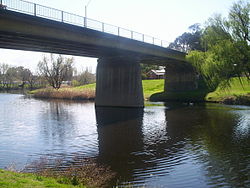| Queanbeyan Burra Creek, Sallee Creek[1] | |
|---|---|
 Road bridge carrying the Kings Highway over the Queanbeyan River, in Queanbeyan | |
| Etymology | Aboriginal (Ngarigu): "clearwater"[2] |
| Location | |
| Country | Australia |
| State/terr. | |
| Regions | |
| Local government areas | |
| City | Queanbeyan |
| Physical characteristics | |
| Source | Gourock Range |
| • location | east of Bredbo, New South Wales |
| • coordinates | 35°56′24″S 149°27′35″E / 35.94000°S 149.45972°E |
| • elevation | 1,260 m (4,130 ft) |
| Mouth | confluence with the Molonglo River |
• location | Oaks Estate, Australian Capital Territory |
• coordinates | 35°20′13″S 149°13′51″E / 35.33694°S 149.23083°E |
• elevation | 567 m (1,860 ft) |
| Length | 104 km (65 mi) |
| Basin size | 96,000 km2 (37,000 sq mi) |
| Basin features | |
| River system | Murrumbidgee catchment, Murray-Darling basin |
| Reservoirs | Googong Reservoir, Queanbeyan Weir |
| [3] | |
The Queanbeyan River, a perennial stream[1] that is part of the Molonglo catchment within the Murray–Darling basin, is located in the Monaro and Capital Country regions of New South Wales and the Australian Capital Territory, in Australia. The river is 104 kilometres (65 mi) in length with a catchment area of 96,000 hectares (240,000 acres). The Queanbeyan River and the Cotter River meet the potable water supply needs of the Canberra and Queanbeyan region and whose water quality is specifically protected under Federal legislation.
It is believed that the local Aboriginal Ngarigo people used a word that sounded like queanbeyan to describe the river, said to mean "clearwater".[2]
- ^ a b "Queanbeyan River". Geographical Names Register (GNR) of NSW. Geographical Names Board of New South Wales. Retrieved 21 January 2013.
- ^ a b "Queanbeyan". Geographical Names Register (GNR) of NSW. Geographical Names Board of New South Wales. Retrieved 21 January 2013.
- ^ "Map of Queanbeyan River". Bonzle Digital Atlas of Australia. Retrieved 21 January 2013.
